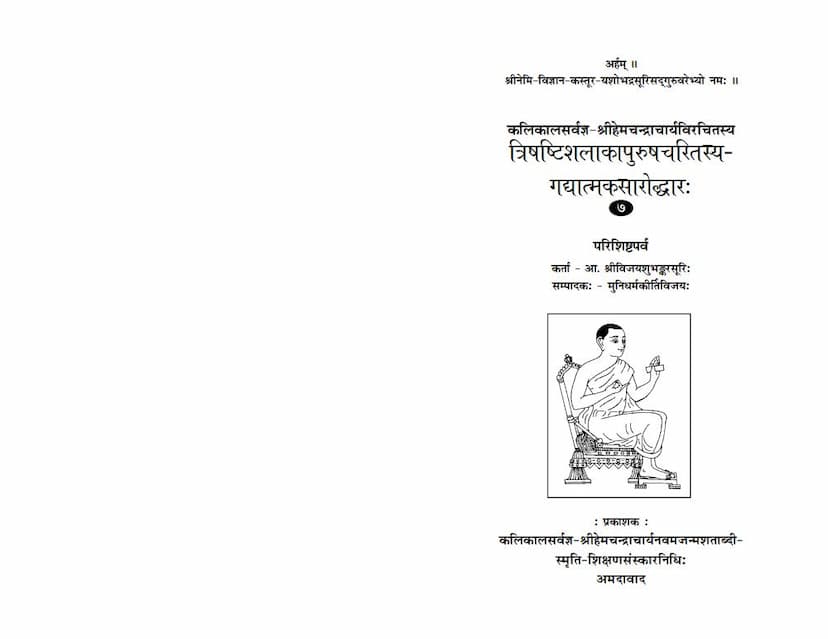Trishashti Shalaka Purush Charitrasya Gadyatmaka Saroddhar Part 07
Added to library: September 2, 2025

Summary
The provided text is the seventh part of a prose summary (Gadyatmaka Saroddhar) of the epic Jain work "Trishashti Shalaka Purush Charitra" (Lives of Sixty-three Illustrious Persons), originally composed by Acharya Hemchandracharya. This specific volume, Part 7, is subtitled "Parishisht Parva" and was compiled by Acharya Vijay Shubhankarsuri and edited by Muni Dharmkirtivijay. It was published by the "Kalikal Sarvagya Shri Hemchandracharya Navam Janmashatabdi Smruti Sanskar Shikshannidhi" in Ahmedabad.
The book is dedicated to the lineage of Jain monks, starting with Acharya Nemisurisvarji, Vijayajisurishvarji, Kasturijisurishvarji, Yashobhadrasurishvarji, and Shubhankarsurishvarji.
Key aspects from the provided pages:
-
Publisher and Mission: The publisher's note highlights their mission to research and publish ancient texts, honor scholars, and publish the research journal 'Anusandhan', commemorating the ninth birth centenary of Acharya Hemchandracharya. This volume is published as a tribute to the ninth centenary of Acharya Hemchandracharya's accession to the spiritual leadership (Suripad Shatabdi).
-
The Work: The "Trishashti Shalaka Purush Charitra" is described as a vast epic poem (Mahakavya) of approximately 36,000 verses, detailing the lives of the sixty-three illustrious figures in Jainism, including Tirthankaras, Chakravartis, Baladevas, Vasudevas, and Naradas. It's considered essential for understanding Jain philosophy and history, but its epic nature makes it challenging for many.
-
The Prose Summary: This prose summary (Gadyatmaka Saroddhar) was originally composed by Acharya Vijay Shubhankarsuri in 2016 (VS) and re-edited and re-researched by Muni Dharmkirtivijay in 2012 (CE). The aim is to simplify the complex epic for easier comprehension.
-
Content Structure (Table of Contents): The table of contents reveals the structure of this volume, focusing on the "Parishisht Parva," which covers a range of stories and narratives. The listed chapters (Sargas) include:
- First Chapter: The story of King Shrenik, King Prasannachandra, the story of the bark-clad ascetic, the previous birth story of Jambu Swami, the stories of Bhavadatta-Bhavadeva, Sagardatta, and Shivakumar.
- Second Chapter: The story of Jambu Swami, the story of the thief Prabhav, the story of Madhubindu, and the stories of Kuberadatta, Maheshwardatta, the farmer, and the crow.
- Third Chapter: Stories of Acharya Yashobhadra and others, the story of Annikapurta, the history of Pataliputra, and the coronation of Nand.
- Fourth Chapter: The arrival of Sudharma Swami in Champa, King Kukunika's visit, and the Kevala Jnana and Nirvana of Jambu Swami.
- Fifth Chapter: The life story of Acharya Shyyambhav, the story of Sthulabhadra and Dhana Deva.
- Sixth Chapter: Stories of Vanara, Angarakarak pandita, Vidyunmala, Shankhadhamaka, and Shailaya Vanara.
- Seventh Chapter: The story of Kalpaka.
- Eighth Chapter: The story of Minister Shakatal and Sri Sthulabhadra, and the stories of Chanakya and Chandragupta.
- Ninth Chapter: The stories of Ashokashri, Kunala, and Samprati.
- Tenth Chapter: Stories of Sthavira, the pedigree horse, Gramakutasut, Shollaka, Masahasapakshika, Mitra Traya, and Nagashri.
- Eleventh Chapter: The stories of Arya Mahagiri and Arya Suhasthi, and the story of Avantikumala.
- Twelfth Chapter: The story of Dhana Giri, the story of Vajraswami, Arya Rakshit, Vajraswami's departure, Vajrasena, and Vajraswami's departure to heaven.
- Thirteenth Chapter: The story of Arya Rakshit, Vajraswami's wanderings, Vajraswami's departure to heaven, Vajrasena's wanderings, and Vajraswami's departure to heaven.
-
Content Focus of First Few Chapters: The beginning of the first chapter sets a scene in the prosperous kingdom of Magadha, describing the city of Rajagriha. It then introduces King Shrenik, his devotion to Jainism, and his visit to Lord Mahavir Swami's sermon. The narrative then delves into the story of King Prasannachandra, his renunciation, and his meditative practices, highlighting a conversation between two soldiers about his penance. This leads to an interaction with Lord Mahavir, who explains the nature of Prasannachandra's meditation and its karmic consequences. The text then transitions to the story of King Somachandra, his renunciation due to old age, and his life in the forest with his wife Dharini, focusing on their ascetic practices and the birth and upbringing of their son, Valkalachiri.
The summary indicates a detailed and rich narrative tradition, covering multiple life stories and moral lessons within the framework of Jainism. The text emphasizes the importance of right intention and right meditation (Shukla Dhyana) in determining one's karmic destiny.